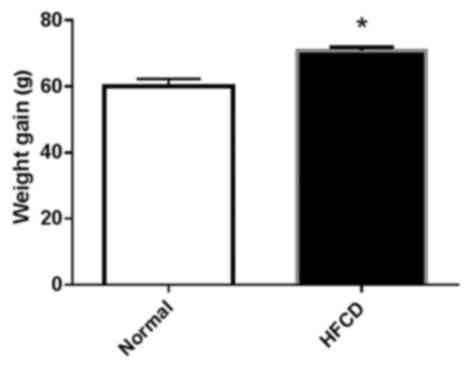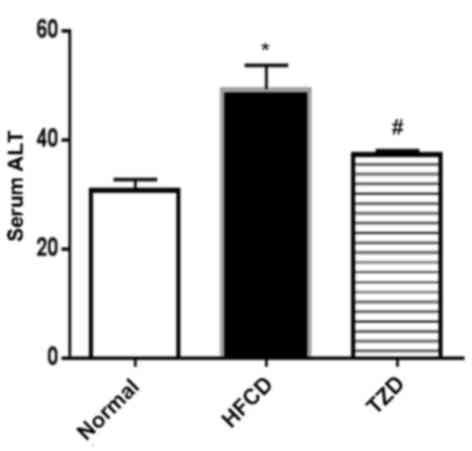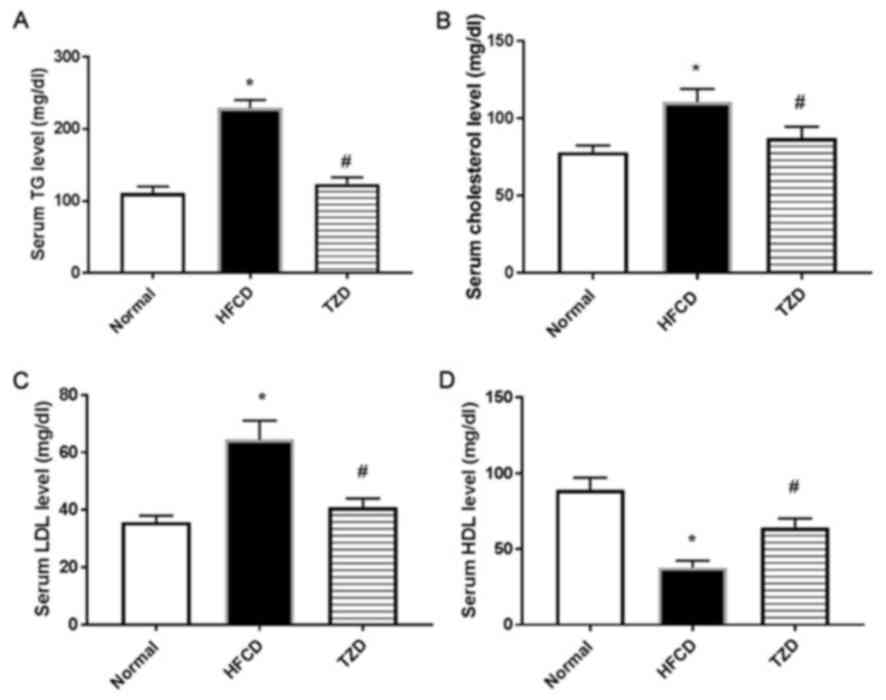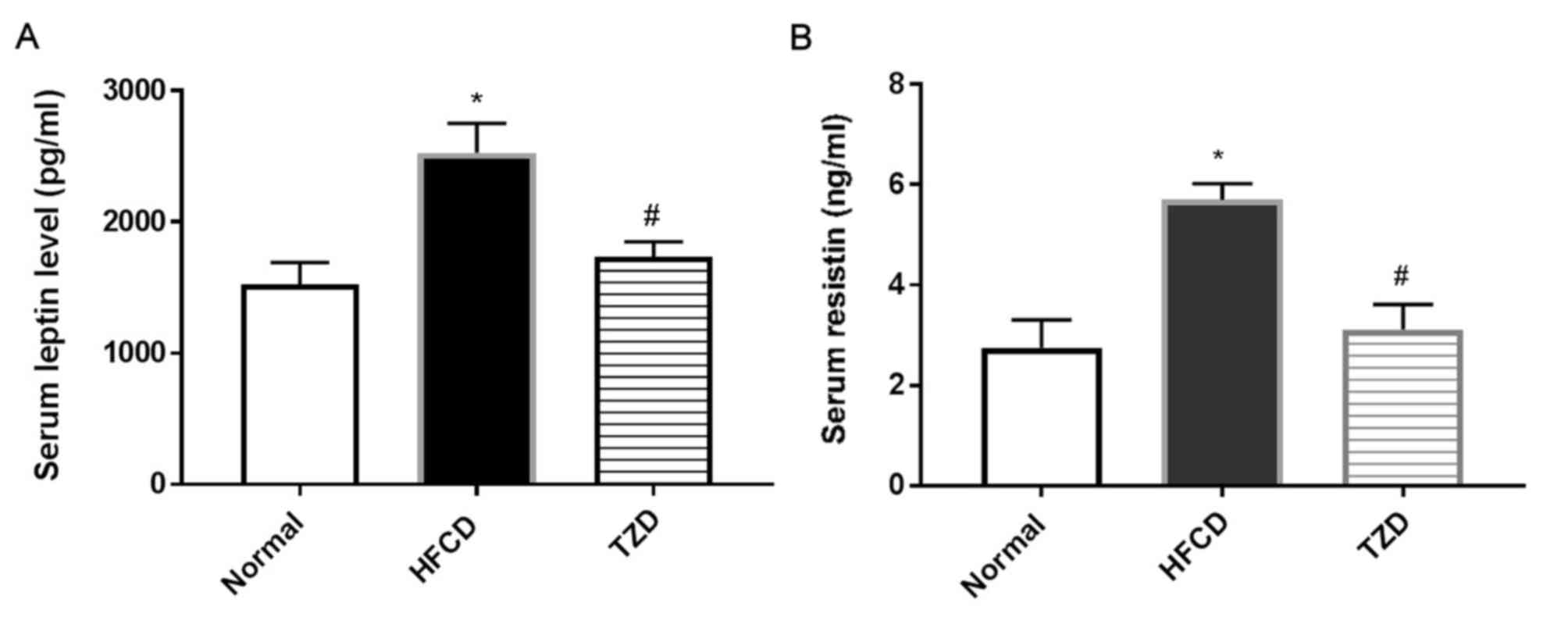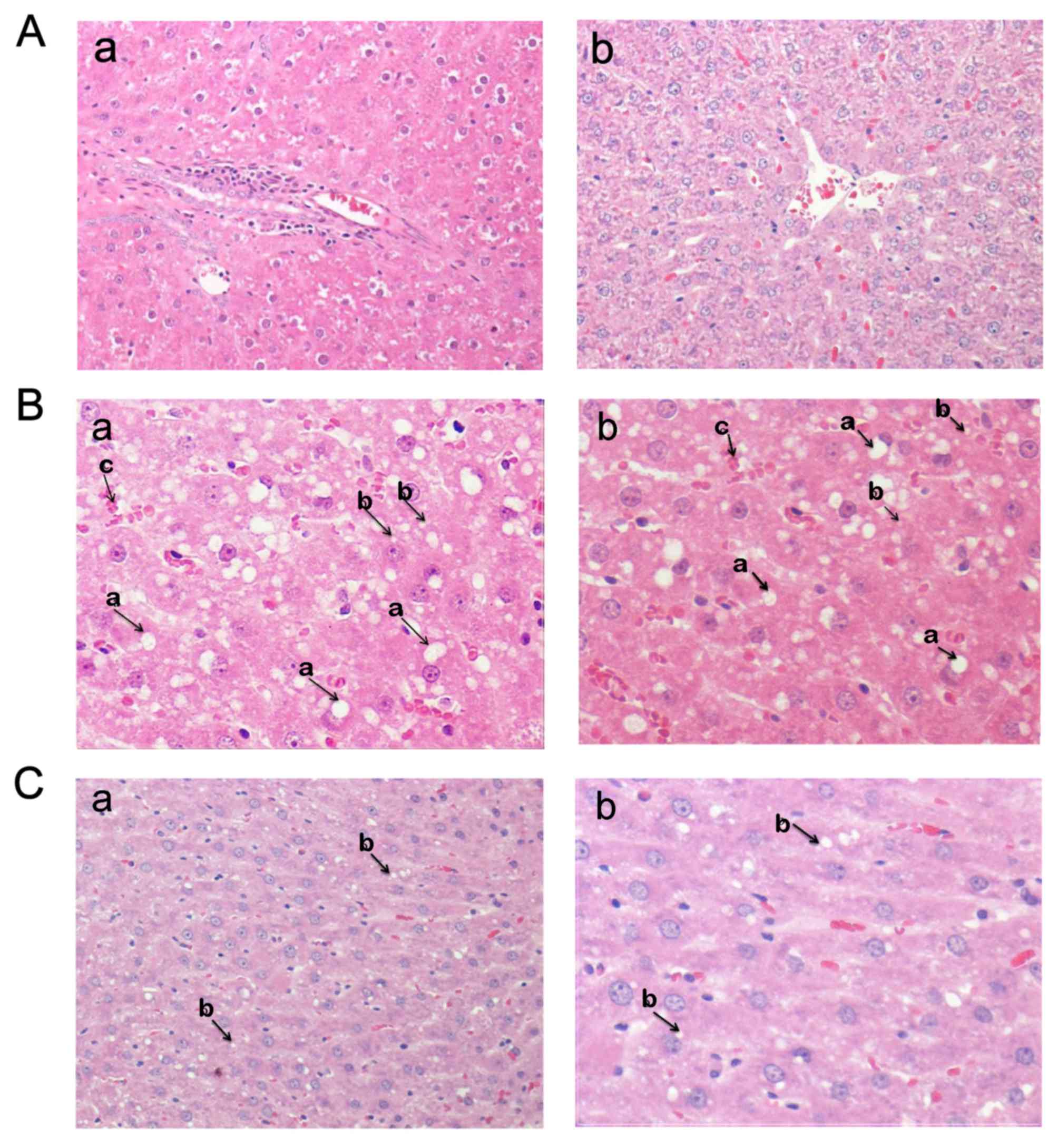|
1
|
Noureddin M, Mato JM and Lu SC:
Nonalcoholic fatty liver disease: Update on pathogenesis,
diagnosis, treatment and the role of S-adenosylmethionine. Exp Biol
Med (Maywood). 240:809–820. 2015. View Article : Google Scholar : PubMed/NCBI
|
|
2
|
Tarantino G, Savastano S and Colao A:
Hepatic steatosis, low-grade chronic inflammation and
hormone/growth factor/adipokine imbalance. World J Gastroenterol.
16:4773–8783. 2010. View Article : Google Scholar : PubMed/NCBI
|
|
3
|
Younossi ZM, Koenig AB, Abdelatif D, Fazel
Y, Henry L and Wymer M: Global epidemiology of nonalcoholic fatty
liver disease-Meta-analytic assessment of prevalence, incidence,
and outcomes. Hepatology. 64:73–84. 2016. View Article : Google Scholar : PubMed/NCBI
|
|
4
|
Araújo AR, Rosso N, Bedogni G, Tiribelli C
and Bellentani S: Global epidemiology of non-alcoholic fatty liver
disease/non-alcoholic steatohepatitis: What we need in the future.
Liver Int. 38 Suppl 1:S47–S51. 2018. View Article : Google Scholar
|
|
5
|
Xu P, Zhang XG, Li YM, Yu CH, Xu L and Xu
GY: Research on the protection effect of pioglitazone for
non-alcoholic fatty liver disease (NAFLD) in rats. J Zhejiang Univ
Sci B. 7:627–633. 2006. View Article : Google Scholar : PubMed/NCBI
|
|
6
|
Hardy T, Anstee QM and Day CP:
Nonalcoholic fatty liver disease: New treatments. Curr Opin
Gastroenterol. 31:175–183. 2015. View Article : Google Scholar : PubMed/NCBI
|
|
7
|
El-Kader Abd SM and El-Den Ashmawy EM:
Non-alcoholic fatty liver disease: The diagnosis and management.
World J Hepatol. 7:846–858. 2015. View Article : Google Scholar : PubMed/NCBI
|
|
8
|
Lomonaco R, Chen J and Cusi K: An
endocrine perspective of nonalcoholic fatty liver disease (NAFLD).
Ther Adv Endocrinol Metab. 2:211–225. 2011. View Article : Google Scholar : PubMed/NCBI
|
|
9
|
Starley BQ, Calcagno CJ and Harrison SA:
Nonalcoholic fatty liver disease and hepatocellular carcinoma: A
weighty connection. Hepatology. 51:1820–1832. 2010. View Article : Google Scholar : PubMed/NCBI
|
|
10
|
Gitto S, Vitale G, Villa E and Andreone P:
Treatment of nonalcoholic steatohepatitis in adults: Present and
future. Gastroenterol Res Pract. 2015:7328702015. View Article : Google Scholar : PubMed/NCBI
|
|
11
|
Wójcik-Cichy K, Koślińska-Berkan E and
Piekarska A: The influence of NAFLD on the risk of atherosclerosis
and cardiovascular diseases. Clin Exp Hepatol. 4:1–6. 2018.
View Article : Google Scholar : PubMed/NCBI
|
|
12
|
Sun DQ, Liu WY, Wu SJ, Zhu GQ, Braddock M,
Zhang DC, Shi KQ, Song D and Zhen MH: Increased levels of
low-density lipoprotein cholesterol within the normal range as a
risk factor for nonalcoholic fatty liver disease. Oncotarget.
7:5728–5737. 2016.PubMed/NCBI
|
|
13
|
Davidson MA, Mattison DR, Azoulay L and
Krewski D: Thiazolidinedione drugs in the treatment of type 2
diabetes mellitus: Past, present and future. Crit Rev Toxicol.
48:52–108. 2018. View Article : Google Scholar : PubMed/NCBI
|
|
14
|
Betteridge DJ: Effects of pioglitazone on
lipid and lipoprotein metabolism. Diabetes Obes Metab. 9:640–647.
2007. View Article : Google Scholar : PubMed/NCBI
|
|
15
|
Takahashi Y, Sugimoto K, Inui H and
Fukusato T: Current pharmacological therapies for nonalcoholic
fatty liver disease/nonalcoholic steatohepatitis. World J
Gastroenterol. 21:3777–3785. 2015. View Article : Google Scholar : PubMed/NCBI
|
|
16
|
Herz M, Johns D, Reviriego J, Grossman LD,
Godin C, Duran S, Hawkins F, Lochnan H, Escobar-Jiménez F, Hardin
PA, et al: A randomized, double-blind, placebo-controlled, clinical
trial of the effects of pioglitazone on glycemic control and
dyslipidemia in oral antihyperglycemic medication-naive patients
with type 2 diabetes mellitus. Clin Ther. 25:1074–1095. 2003.
View Article : Google Scholar : PubMed/NCBI
|
|
17
|
de Souza CJ, Eckhardt M, Gagen K, Dong M,
Chen W, Laurent D and Burkey BF: Effects of pioglitazone on adipose
tissue remodeling within the setting of obesity and insulin
resistance. Diabetes. 50:1863–1871. 2001. View Article : Google Scholar : PubMed/NCBI
|
|
18
|
Ochiai M and Matsuo T:
Pioglitazone-induced increase in the stearoyl-CoA desaturation
index and fat accumulation in rat muscles are not related to
lipoprotein lipase activity. J Oleo Sci. 62:745–754. 2013.
View Article : Google Scholar : PubMed/NCBI
|
|
19
|
Ntambi JM and Miyazaki M: Regulation of
stearoyl-CoA desaturases and role in metabolism. Prog Lipid Res.
43:91–104. 2004. View Article : Google Scholar : PubMed/NCBI
|
|
20
|
Paton CM and Ntambi JM: Biochemical and
physiological function of stearoyl-CoA desaturase. Am J Physiol
Endocrinol Metab. 297:E28–E37. 2009. View Article : Google Scholar : PubMed/NCBI
|
|
21
|
Marques-Lopes I, Ansorena D, Astiasaran I,
Forga L and Martínez JA: Postprandial de novo lipogenesis and
metabolic changes induced by a high-carbohydrate, low-fat meal in
lean and overweight men. Am J Clin Nutr. 73:253–261. 2001.
View Article : Google Scholar : PubMed/NCBI
|
|
22
|
Jia C, Huan Y, Liu S, Hou S, Sun S, Li C,
Liu Q, Jiang Q, Wang Y and Shen Z: Effect of chronic pioglitazone
treatment on hepatic gene expression profile in obese C57BL/6J
Mice. Int J Mol Sci. 16:12213–1229. 2015. View Article : Google Scholar : PubMed/NCBI
|
|
23
|
Peng J, Huan Y, Jiang Q, Sun SJ, Jia CM
and Shen ZF: Effects and potential mechanisms of pioglitazone on
lipid metabolism in obese diabetic KKAy Mice. PPAR Res.
2014:5381832014. View Article : Google Scholar : PubMed/NCBI
|
|
24
|
Yao-Borengasser A, Rassouli N, Varma V,
Bodles AM, Rasouli N, Unal R, Phanavanh B, Ranganathan G, McGehee
RE Jr and Kern PA: Stearoyl-coenzyme A desaturase 1 gene expression
increases after pioglitazone treatment and is associated with
peroxisomal proliferator-activated receptor-gamma responsiveness. J
Clin Endocrinol Metab. 93:4431–4439. 2008. View Article : Google Scholar : PubMed/NCBI
|
|
25
|
Ntambi JM, Miyazaki M, Stoehr JP, Lan H,
Kendziorski CM, Yandell BS, Song Y, Cohen P, Friedman JM and Attie
AD: Loss of stearoyl-CoA desaturase-1 function protects mice
against adiposity. Proc Natl Acad Sci USA. 99:11482–18486. 2002.
View Article : Google Scholar : PubMed/NCBI
|
|
26
|
Toyama T, Kudo N, Hibino Y, Mitsumoto A,
Nishikawa M and Kawashima Y: Effects of pioglitazone on
stearoyl-CoA desaturase in obese Zucker fa/fa rats. J Pharmacol
Sci. 104:137–145. 2007. View Article : Google Scholar : PubMed/NCBI
|
|
27
|
Boutari C, Perakakis N and Mantzoros CS:
Association of adipokines with development and progression of
nonalcoholic fatty liver disease. Endocrinol Metab (Seoul).
33:33–43. 2018. View Article : Google Scholar : PubMed/NCBI
|
|
28
|
Al-Muzafar HM and Amin KA: Probiotic
improves fatty liver disease by virtue of its action on lipid
profiles, leptin, and inflammatory biomarkers. BMC Complement
Altern Med. 17:432017. View Article : Google Scholar : PubMed/NCBI
|
|
29
|
Liang W, Menke AL, Driessen A, Koek GH,
Lindeman JH, Stoop R, Havekes LM, Kleemann R and van den Hoek AM:
Establishment of a general NAFLD scoring system for rodent models
and comparison to human liver pathology. PLoS One. 9:e1159222014.
View Article : Google Scholar : PubMed/NCBI
|
|
30
|
Mikolasevic I, Milic S, Wensveen Turk T,
Grgic I, Jakopcic I, Stimac D, Wensveen F and Orlic L: Nonalcoholic
fatty liver disease-A multisystem disease? World J Gastroenterol.
22:9488–9505. 2016. View Article : Google Scholar : PubMed/NCBI
|
|
31
|
Marino L and Jornayvaz FR: Endocrine
causes of nonalcoholic fatty liver disease. World J Gastroenterol.
1:11053–11076. 2015. View Article : Google Scholar
|
|
32
|
Tilg H and Moschen AR: Evolution of
inflammation in nonalcoholic fatty liver disease: The multiple
parallel hits hypothesis. Hepatology. 52:1836–1846. 2010.
View Article : Google Scholar : PubMed/NCBI
|
|
33
|
Pang Y, Kartsonaki C, Turnbull I, Guo Y,
Clarke R, Chen Y, Bragg F, Yang L, Bian Z, Millwood IY, et al:
Diabetes, plasma glucose and incidence of fatty liver, cirrhosis
and liver cancer: A prospective study of 0.5 million people.
Hepatology. 2018.(Epub ahead of print). View Article : Google Scholar
|
|
34
|
Zelber-Sagi S, Godos J and Salomone F:
Lifestyle changes for the treatment of nonalcoholic fatty liver
disease: A review of observational studies and intervention trials.
Therap Adv Gastroenterol. 9:392–407. 2016. View Article : Google Scholar : PubMed/NCBI
|
|
35
|
Mazzotti A, Caletti MT, Marchignoli F,
Forlani G and Marchesini G: Which treatment for type 2 diabetes
associated with non-alcoholic fatty liver disease? Dig Liver Dis.
49:235–240. 2017. View Article : Google Scholar : PubMed/NCBI
|
|
36
|
El-Haleim Abd EA, Bahgat AK and Saleh S:
Effects of combined PPAR-γ and PPAR-α agonist therapy on fructose
induced NASH in rats: Modulation of gene expression. Eur J
Pharmacol. 773:59–70. 2016. View Article : Google Scholar : PubMed/NCBI
|
|
37
|
Wang G, Wang X, Zhang Q and Ma Z: Response
to pioglitazone treatment is associated with the lipoprotein lipase
S447X variant in subjects with type 2 diabetes mellitus. Int J Clin
Pract. 61:552–557. 2007. View Article : Google Scholar : PubMed/NCBI
|
|
38
|
He L, Liu X, Wang L and Yang Z:
Thiazolidinediones for nonalcoholic steatohepatitis: A
meta-analysis of randomized clinical trials. Medicine (Baltimore).
95:e49472016. View Article : Google Scholar : PubMed/NCBI
|
|
39
|
Al Majali K, Cooper MB, Staels B, Luc G,
Taskinen MR and Betteridge DJ: The effect of sensitisation to
insulin with pioglitazone on fasting and postprandial lipid
metabolism, lipoprotein modification by lipases, and lipid transfer
activities in type 2 diabetic patients. Diabetologia. 49:527–537.
2006. View Article : Google Scholar : PubMed/NCBI
|
|
40
|
Corey KE, Vuppalanchi R, Wilson LA,
Cummings OW and Chalasani N: NASH resolution is associated with
improvements in HDL and triglyceride levels but not improvement in
LDL or non-HDL-C levels. Aliment Pharmacol Ther. 41:301–309. 2015.
View Article : Google Scholar : PubMed/NCBI
|
|
41
|
Zaitone SA, Barakat BM, Bilasy SE, Fawzy
MS, Abdelaziz EZ and Farag NE: Protective effect of boswellic acids
versus pioglitazone in a rat model of diet-induced non-alcoholic
fatty liver disease: Influence on insulin resistance and energy
expenditure. Naunyn Schmiedebergs Arch Pharmacol. 388:587–600.
2015. View Article : Google Scholar : PubMed/NCBI
|
|
42
|
Djaouti L, Jourdan T, Demizieux L, Chevrot
M, Gresti J, Vergès B and Degrace P: Different effects of
pioglitazone and rosiglitazone on lipid metabolism in mouse
cultured liver explants. Diabetes Metab Res Rev. 26:297–305. 2010.
View Article : Google Scholar : PubMed/NCBI
|
|
43
|
LeBrasseur NK, Kelly M, Tsao TS, Farmer
SR, Saha AK, Ruderman NB and Tomas E: Thiazolidinediones can
rapidly activate AMP-activated protein kinase in mammalian tissues.
75-E181. Am J Physiol Endocrinol Metab. 291:E175–E181. 2006.
View Article : Google Scholar : PubMed/NCBI
|
|
44
|
Saha AK, Avilucea PR, Ye JM, Assifi MM,
Kraegen EW and Ruderman NB: Pioglitazone treatment activates
AMP-activated protein kinase in rat liver and adipose tissue in
vivo. Biochem Biophys Res Commun. 314:580–585. 2004. View Article : Google Scholar : PubMed/NCBI
|
|
45
|
Banini BA and Sanyal AJ: Current and
future pharmacologic treatment of nonalcoholic steatohepatitis.
Curr Opin Gastroenterol. 33:134–141. 2017. View Article : Google Scholar : PubMed/NCBI
|
|
46
|
Mohan SK, Veeraraghavan VP and Jainu M:
Effect of pioglitazone, quercetin and hydroxy citric acid on
extracellular matrix components in experimentally induced
non-alcoholic steatohepatitis. Iran J Basic Med Sci. 18:832–836.
2015.PubMed/NCBI
|
|
47
|
Steppan CM, Bailey ST, Bhat S, Brown EJ,
Banerjee RR, Wright CM, Patel HR, Ahima RS and Lazar MA: The human
Resistin links obesity to diabetes. Nature. 409:307–312. 2001.
View Article : Google Scholar : PubMed/NCBI
|
|
48
|
Jamaluddin MS, Weakley SM, Yao Q and Chen
C: Resistin: functional roles and therapeutic considerations for
cardiovascular disease. Br J Pharmacol. 165:622–632. 2012.
View Article : Google Scholar : PubMed/NCBI
|
|
49
|
Kubota N, Terauchi Y, Kubota T, Kumagai H,
Itoh S, Satoh H, Yano W, Ogata H, Tokuyama K, Takamoto I, et al:
Pioglitazone ameliorates insulin resistance and diabetes by both
adiponectin-dependent and -independent pathways. J Biol Chem.
281:8748–8755. 2006. View Article : Google Scholar : PubMed/NCBI
|
|
50
|
Dongiovanni P, Rametta R, Meroni M and
Valenti L: The role of insulin resistance in nonalcoholic
steatohepatitis and liver disease development-a potential
therapeutic target? Expert Rev Gastroenterol Hepatol. 10:229–242.
2016. View Article : Google Scholar : PubMed/NCBI
|
|
51
|
Bajaj M, Suraamornku S, Hardies LJ,
Pratipanawatr T and DeFronzo RA: Plasma resistin concentration,
hepatic fat content, and hepatic and peripheral insulin resistance
in pioglitazone-treated type II diabetic patients. Int J Obes Relat
Metab Disord. 28:783–789. 2004. View Article : Google Scholar : PubMed/NCBI
|
|
52
|
Park HK and Ahima RS: Physiology of
leptin: Energy homeostasis, neuroendocrine function and metabolism.
Metabolism. 64:24–34. 2015. View Article : Google Scholar : PubMed/NCBI
|
|
53
|
Cedernaes J, Alsiö J, Västermark A,
Risérus U and Schiöth HB: Adipose tissue stearoyl-CoA desaturase 1
index is increased and linoleic acid is decreased in obesity-prone
rats fed a high-fat diet. Lipids Health Dis. 12:22013. View Article : Google Scholar : PubMed/NCBI
|
|
54
|
Amitani M, Asakawa A, Amitani H and Inui
A: The role of leptin in the control of insulin-glucose axis. Front
Neurosci. 7:512013. View Article : Google Scholar : PubMed/NCBI
|
|
55
|
Zhou Y and Rui L: Leptin signaling and
leptin resistance: Front Med. 7:207–222. 2013.
|
|
56
|
Huang XD, Fan Y, Zhang H, Wang P, Yuan JP,
Li MJ and Zhan XY: Serum leptin and soluble leptin receptor in
non-alcoholic fatty liver disease. World J Gastroenterol.
14:2888–2893. 2008. View Article : Google Scholar : PubMed/NCBI
|
|
57
|
Canbakan B, Tahan V, Balci H, Hatemi I,
Erer B, Ozbay G, Sut N, Hacibekiroglu M, Imeryuz N and Senturk H:
Leptin in nonalcoholic fatty liver disease. Ann Hepatol. 7:249–254.
2008.PubMed/NCBI
|
|
58
|
Cohen P, Ntambi JM and Friedman JM:
Stearoyl-CoA desaturase-1 and the metabolic syndrome. Curr Drug
Targets Immune Endocr Metabol Disord. 3:271–280. 2003. View Article : Google Scholar : PubMed/NCBI
|
|
59
|
D'souza AM, Neumann UH, Glavas MM and
Kieffer TJ: The glucoregulatory actions of leptin. Mol Metab.
6:1052–1065. 2017. View Article : Google Scholar : PubMed/NCBI
|
|
60
|
He J, Xu C, Kuang J, Liu Q, Jiang H, Mo L,
Geng B and Xu G: Thiazolidinediones attenuate lipolysis and
ameliorate dexamethasone-induced insulin resistance. Metabolism.
64:826–836. 2015. View Article : Google Scholar : PubMed/NCBI
|
|
61
|
Adams LA, Anstee QM, Tilg H and Targher G:
Non-alcoholic fatty liver disease and its relationship with
cardiovascular disease and other extrahepatic diseases. Gut.
66:1138–1153. 2017. View Article : Google Scholar : PubMed/NCBI
|
|
62
|
Dobrzyn P, Ntambi JM and Dobrzyn A:
Stearoyl-CoA desaturase: A novel control point of lipid metabolism
and insulin sensitivity. Eur J Lipid Sci Technol. 110:93–100. 2008.
View Article : Google Scholar
|
|
63
|
Heinemann FS and Ozols J: Stearoyl-CoA
desaturase, a short-lived protein of endoplasmic reticulum with
multiple control mechanisms. Prostaglandins Leukot. Essent Fatty
Acids. 68:122–133. 2003. View Article : Google Scholar
|
|
64
|
Chong MF, Hodson L, Bickerton AS, Roberts
R, Neville M, Karpe F, Frayn KN and Fielding BA: Parallel
activation of de novo lipogenesis and stearoyl-CoA desaturase
activity after 3 d of high-carbohydrate feeding. Am J Clin Nutr.
87:817–823. 2008. View Article : Google Scholar : PubMed/NCBI
|
|
65
|
Cohen P and Friedman JM: Leptin and the
control of metabolism: Role for stearoyl-CoA desaturase-1(SCD-1). J
Nutr. 134:2455S–2463S. 2004. View Article : Google Scholar : PubMed/NCBI
|
|
66
|
Dobrzyn A and Ntambi JM: The role of
stearoyl-CoA desaturase in body weight regulation. Trends
Cardiovasc Med. 14:77–81. 2004. View Article : Google Scholar : PubMed/NCBI
|
|
67
|
Dobrzyn P, Jazurek M and Dobrzyn A:
Stearoyl-CoA desaturase and insulin signaling-what is the molecular
switch? Biochim Biophys Acta. 1797:1189–1194. 2010. View Article : Google Scholar : PubMed/NCBI
|
|
68
|
Von Loeffelholz C, Döcke S, Lock JF,
Lieske S, Horn P, Kriebel J, Wahl S, Singmann P, de Las Heras Gala
T, Grallert H, et al: Increased lipogenesis in spite of upregulated
hepatic 5′AMP-activated protein kinase in human non-alcoholic fatty
liver. Hepatol Res. 47:890–901. 2017. View Article : Google Scholar : PubMed/NCBI
|
|
69
|
Lee JJ, Lambert JE, Hovhannisyan Y,
Ramos-Roman MA, Trombold JR, Wagner DA and Parks EJ: Palmitoleic
acid is elevated in fatty liver disease and reflects hepatic
lipogenesis. Am J Clin Nutr. 101:34–43. 2015. View Article : Google Scholar : PubMed/NCBI
|
|
70
|
Gaggini M, Cabiati M, Del Turco S, Navarra
T, De Simone P, Filipponi F, Del Ry S, Gastaldelli A and Basta G:
Increased FNDC5/Irisin expression in human hepatocellular
carcinoma. Peptides. 88:62–66. 2017. View Article : Google Scholar : PubMed/NCBI
|
|
71
|
Mock K, Lateef S, Benedito VA and Tou JC:
High-fructose corn syrup-55 consumption alters hepatic lipid
metabolism and promotes triglyceride accumulation. J Nutr Biochem.
39:32–39. 2017. View Article : Google Scholar : PubMed/NCBI
|
|
72
|
Liu L, Wang S, Yao L, Li JX, Ma P, Jiang
LR, Ke DZ, Pan YQ and Wang JW: Long-term fructose consumption
prolongs hepatic stearoyl-CoA desaturase 1 activity independent of
upstream regulation in rats. Biochem Biophys Res Commun.
479:643–648. 2016. View Article : Google Scholar : PubMed/NCBI
|
|
73
|
Hulver MW, Berggren JR, Carper MJ,
Miyazaki M, Ntambi JM, Hoffman EP, Thyfault JP, Stevens R, Dohm GL,
Houmard JA, et al: Elevated stearoyl-CoA desaturase-1 expression in
skeletal muscle contributes to abnormal fatty acid partitioning in
obese humans. Cell Metabolism. 2:251–261. 2005. View Article : Google Scholar : PubMed/NCBI
|
|
74
|
Hellemans KH, Hannaert JC, Denys B,
Steffensen KR, Raemdonck C, Martens GA, Van Veldhoven PP,
Gustafsson JA and Pipeleers D: Susceptibility of pancreatic beta
cells to fatty acids is regulated by LXR/PPARα-dependent
stearoyl-coenzyme a desaturase. PLoS One. 4:e72662009. View Article : Google Scholar : PubMed/NCBI
|
|
75
|
Chiu S, Mulligan K and Schwarz JM: Dietary
carbohydrates and atty liver disease: De novo lipogenesis. Curr
Opin Clin Nutr Metab Care. 21:277–282. 2018. View Article : Google Scholar : PubMed/NCBI
|
|
76
|
Softic S, Cohen DE and Kahn CR: Role of
dietary fructose and hepatic de novo Lipogenesis in fatty liver
disease. Dig Dis Sci. 61:1282–1293. 2016. View Article : Google Scholar : PubMed/NCBI
|
|
77
|
Silbernagel G, Kovarova M, Cegan A,
Machann J, Schick F, Lehmann R, Häring HU, Stefan N, Schleicher E,
Fritsche A and Peter A: High hepatic SCD1 activity is associated
with low liver fat content in healthy subjects under a lipogenic
diet. J Clin Endocrinol Metab. 97:E2288–E2292. 2012. View Article : Google Scholar : PubMed/NCBI
|
|
78
|
Kurebayashi S, Hirose T, Miyashita Y,
Kasayama S and Kishimoto T: Thiazolidinediones downregulate
stearoyl-CoA desaturase 1 gene expression in 3T3-L1 adipocytes.
Diabetes. 46:2115–2118. 1997. View Article : Google Scholar : PubMed/NCBI
|
|
79
|
Sun S, Zhang Z, Pokrovskaia N, Chowdhury
S, Jia Q, Chang E, Khakh K, Kwan R, McLaren DG, Radomski CC, et al:
Discovery of triazolone derivatives as novel, potent stearoyl-CoA
desaturase-1 (SCD1) inhibitors. Bioorg Med Chem. 23:455–465. 2015.
View Article : Google Scholar : PubMed/NCBI
|
|
80
|
Meshkani R, Sadeghi A, Taheripak G,
Zarghooni M, Gerayesh-Nejad S and Bakhtiyari S: Rosiglitazone, a
PPARγ agonist, ameliorates palmitate-induced insulin resistance and
apoptosis in skeletal muscle cells. Cell Biochem Funct. 32:683–691.
2014. View Article : Google Scholar : PubMed/NCBI
|
|
81
|
Ikeda J, Ichiki T, Takahara Y, Kojima H,
Sankoda C, Kitamoto S, Tokunou T and Sunagawa K: PPARγ agonists
attenuate palmitate-induced ER stress through up-regulation of
SCD-1 in macrophages. PLoS One. 10:e01285462015. View Article : Google Scholar : PubMed/NCBI
|
|
82
|
Risérus U, Tan GD, Fielding BA, Neville
MJ, Currie J, Savage DB, Chatterjee VK, Frayn KN, O'Rahilly S and
Karpe F: Rosiglitazone increases indexes of stearoyl-CoA desaturase
activity in humans: Link to insulin sensitization and the role of
dominant-negative mutation in peroxisome proliferator-activated
receptor-gamma. Diabetes. 54:1379–1384. 2005. View Article : Google Scholar : PubMed/NCBI
|
|
83
|
Leekumjorn S, Cho HJ, Wu Y, Wright NT, Sum
AK and Chan C: The role of fatty acid unsaturation in minimizing
biophysical changes on the structure and local effects of bilayer
membranes. Biochim Biophys Acta. 1788:1508–1516. 2009. View Article : Google Scholar : PubMed/NCBI
|
|
84
|
Leamy AK, Egnatchik RA and Young JD:
Molecular mechanisms and the role of saturated fatty acids in the
progression of non-alcoholic fatty liver disease. Prog Lipid Res.
52:165–174. 2013. View Article : Google Scholar : PubMed/NCBI
|
|
85
|
Arisqueta L, Navarro-Imaz H, Rueda Y and
Fresnedo O: Cholesterol mobilization from hepatic lipid droplets
during endotoxemia is altered in obese ob/ob mice. J Biochem.
158:321–329. 2015. View Article : Google Scholar : PubMed/NCBI
|
|
86
|
Saliani N, Darabi M, Yousefi B, Baradaran
B, Khaniani MS, Darabi M, Shaaker M, Mehdizadeh A, Naji T and
Hashemi M: PPARγ agonist-induced alterations in Δ6-desaturase and
stearoyl-CoA desaturase 1: Role of MEK/ERK1/2 pathway. World J
Hepatol. 5:220–225. 2013. View Article : Google Scholar : PubMed/NCBI
|















